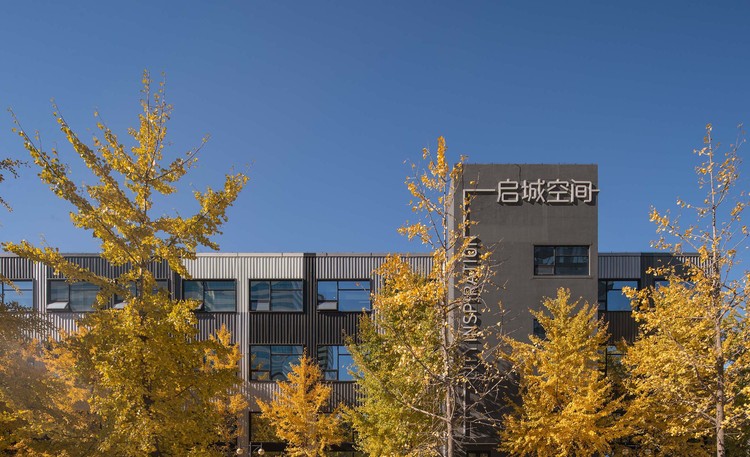House of Architectural Heritage Noura Al Sayeh + Leopold Banchini Architects
2019-01-22 21:00
架构师提供的文本描述。建筑遗产屋是建筑师约翰·雅伍德的素描和素描的档案收藏,也是建筑展览的展览空间。该项目被认为是一个梁结构,框架现有相邻的两个建筑物的墙壁,作为一个展示城市的建筑遗产,旧的和新的。
Text description provided by the architects. The house for Architectural Heritage houses the archival collection of sketches and drawings by the architect John Yarwood, as well as serving as an exhibition space for architecture exhibition. The project is conceived as a beam structure that frames the existing adjacent walls of the two neighbouring buildings, serving as a showcase for the architectural heritage of the city, the old as well as the new.
Text description provided by the architects. The house for Architectural Heritage houses the archival collection of sketches and drawings by the architect John Yarwood, as well as serving as an exhibition space for architecture exhibition. The project is conceived as a beam structure that frames the existing adjacent walls of the two neighbouring buildings, serving as a showcase for the architectural heritage of the city, the old as well as the new.
建筑是城市情节的内在表现,提供了对城市形态的透视,揭示了城市建设的不同阶段。两个主立面包含两个滑动门,可以在梁的高度内被提起,向街道开放展览空间,并将建筑物改造成公共通道。展览空间与街道结合,鼓励更多的公众参与。该项目通过其建筑构想解决了创造文化空间的挑战,这些文化空间对当地社区具有更多的参与性。通过提供一个可以在街道上完全开放的空间,在一个经常感到被排斥的社区所在的社区,该项目试图提供一种新的展览类型。
The building is an intrinsic expression of the urban condition of the plot, offering an x-ray view into the urban form of the city and revealing the different phases of construction that the city has witnessed. The two main facades contain two sliding doors that can be lifted within the height of the beam, opening the exhibition space to the streets, and transforming the building into a public passage. The exhibition space becomes one with the street encouraging more public participation. The project addresses through its architectural conception the challenges of creating cultural spaces that hold a more participatory approach to local communities. By providing a space that can be completely opened on to the streets, in a neighbourhood that houses communities that often feel excluded, the project attempts to provide a new exhibition typology.
The building is an intrinsic expression of the urban condition of the plot, offering an x-ray view into the urban form of the city and revealing the different phases of construction that the city has witnessed. The two main facades contain two sliding doors that can be lifted within the height of the beam, opening the exhibition space to the streets, and transforming the building into a public passage. The exhibition space becomes one with the street encouraging more public participation. The project addresses through its architectural conception the challenges of creating cultural spaces that hold a more participatory approach to local communities. By providing a space that can be completely opened on to the streets, in a neighbourhood that houses communities that often feel excluded, the project attempts to provide a new exhibition typology.
通过在严密的城市结构中小心地插入自己,保护内墙的“发现”状态,该项目冻结了城市发展速度中往往是短暂的城市条件。这座建筑是用钢筋混凝土建造的,横梁横跨地块的26米宽,连接着街道的两边。钢筋混凝土与城市的其他建筑材料、珊瑚石瓦砾和砌块工程并列。混凝土结构是隔热的,而内部空间不受直接阳光照射,大大减少了冷却的需要。
By carefully inserting itself within a tight urban fabric, conserving the "found" state of the inner walls, the project freezes an urban condition that is often transient within the fast pace of development in the city. The building is built in reinforced concrete, with a beam that spans the 26m width of the plot, linking both sides of the street. The reinforced concrete is juxtaposed to the other building materials of the city, coral stone, coral stone rubble and block work. The concrete structure is thermally insulated, while the internal space is shielded from direct sunlight, considerably reducing the need for cooling.
By carefully inserting itself within a tight urban fabric, conserving the "found" state of the inner walls, the project freezes an urban condition that is often transient within the fast pace of development in the city. The building is built in reinforced concrete, with a beam that spans the 26m width of the plot, linking both sides of the street. The reinforced concrete is juxtaposed to the other building materials of the city, coral stone, coral stone rubble and block work. The concrete structure is thermally insulated, while the internal space is shielded from direct sunlight, considerably reducing the need for cooling.
Architects Leopold Banchini Architects, Noura Al Sayeh
Location Muharraq, Bahrain
Client Sh. Ebrahim Centre for Culture & Research
Photography Dylan Perrenoud
 举报
举报
别默默的看了,快登录帮我评论一下吧!:)
注册
登录
更多评论
相关文章
-

描边风设计中,最容易犯的8种问题分析
2018年走过了四分之一,LOGO设计趋势也清晰了LOGO设计
-

描边风设计中,最容易犯的8种问题分析
2018年走过了四分之一,LOGO设计趋势也清晰了LOGO设计
-

描边风设计中,最容易犯的8种问题分析
2018年走过了四分之一,LOGO设计趋势也清晰了LOGO设计

















































































